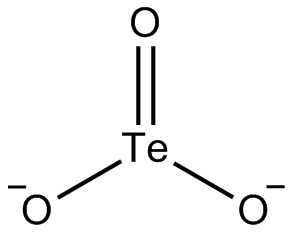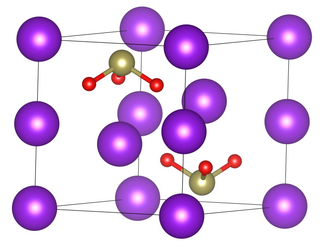
Glasses, also known as eyeglasses or spectacles, are devices consisting of glass or hard plastic lenses mounted in a frame that holds them in front of a person's eyes, typically using a bridge over the nose and arms which rest over the ears.

Corynebacterium diphtheriae is the pathogenic bacterium that causes diphtheria. It is also known as the Klebs-Löffler bacillus, because it was discovered in 1884 by German bacteriologists Edwin Klebs (1834–1912) and Friedrich Löffler (1852–1915).

Tellurite is a rare oxide mineral composed of tellurium dioxide (TeO2).

Tellurium dioxide (TeO2) is a solid oxide of tellurium. It is encountered in two different forms, the yellow orthorhombic mineral tellurite, β-TeO2, and the synthetic, colourless tetragonal (paratellurite), α-TeO2. Most of the information regarding reaction chemistry has been obtained in studies involving paratellurite, α-TeO2.

The tellurite ion is TeO2−
3. A tellurite (compound), for example sodium tellurite, is a compound that contains this ion. They are typically colorless or white salts, which in some ways are comparable to sulfite. A mineral with the formula TeO2 is called tellurite.

Tellurous acid is an inorganic compound with the formula H2TeO3. It is the oxoacid of tellurium(IV). The compound is not well characterized. An alternative way of writing its formula is (HO)2TeO. In principle, tellurous acid would form by treatment of tellurium dioxide with water, that is by hydrolysis. The related conjugate base is well known in the form of several salts such as potassium hydrogen tellurite, KHTeO3.

Sodium tellurite is an inorganic tellurium compound with formula Na2TeO3. It is a water-soluble white solid and a weak reducing agent. Sodium tellurite is an intermediate in the extraction of the element, tellurium; it is a product obtained from anode slimes and is a precursor to tellurium.

Dimethyl telluride is an organotelluride compound, formula (CH3)2Te, also known by the abbreviation DMTe.
Mycobacterium conspicuum is a species of the phylum Actinobacteria, belonging to the genus Mycobacterium.
Hoyle's agar is a selective medium that uses tellurite to differentially select Corynebacterium diphtheriae from other upper respiratory tract flora. The medium appears cream to yellow colored, and takes the form of a free-floating powder. It is a modification of Neill's medium.
Arsenite minerals are very rare oxygen-bearing arsenic minerals. Classical world localities where such minerals occur include the complex skarn manganese deposit at Långban (Sweden) and the polymetallic Tsumeb deposit (Namibia). The most often reported arsenite anion in minerals is the AsO33− anion, present for example in reinerite Zn3(AsO3)2. Unique diarsenite anions occur i. e. in leiteite Zn[As2O4] and paulmooreite Pb[As2O5]. More complex arsenites include schneiderhöhnite Fe2+Fe3+3[As5O13] and ludlockite PbFe3+4As10O22.

Zemannite is a very rare oxide mineral with the chemical formula Mg0.5ZnFe3+[TeO3]3·4.5H2O. It crystallizes in the hexagonal crystal system and forms small prismatic brown crystals. Because of the rarity and small crystal size, zemannite has no applications and serves as a collector's item.

Walfordite is a very rare tellurite mineral that was discovered in Chile in 1999. The mineral is described as orange with orange-yellow streak, and is determined to have a chemical formula of Fe3+,Te6+Te4+3O8 with minor titanium and magnesium substitution resulting in an approximate empirical formula of (Fe3+,Te6+,Ti4+,Mg)(Te4+)3O8.

Emmonsite, also known as durdenite, is an iron tellurite mineral with the formula: Fe2(TeO3)3·2(H2O). Emmonsite forms triclinic crystals. It is of a yellowish-green color, with a vitreous luster, and a hardness of 5 on the Moh scale.
Tellurite methyltransferase is an enzyme with systematic name S-adenosyl-L-methionine:tellurite methyltransferase. This enzyme catalyses the following chemical reaction
The Tellurium Ion Resistance (TerC) Family is part of the Lysine Exporter (LysE) Superfamily. A representative list of proteins belonging to the TerC family can be found in the Transporter Classification Database.
Teineite is a tellurite mineral with the formula Cu(TeO3). 2 H2O. It has a Moh's hardness of 2.5 and it comes in many different shades of blue, ranging from cerulean blue to bluish-gray. The mineral millsite has the same chemical composition, but crystallizes in the monoclinic system, while teineite crystallizes in the orthorhombic system.

Solar viewer is special eyewear designed for direct viewing of the Sun. Standard sunglasses are unable to filter out eye damaging radiation. Solar viewers are required for safe viewing of solar events such as eclipses. The recommended optical density of this eyewear is 5.

Potassium tellurite, K2TeO3, is an inorganic potassium-tellurium compound. It has been used as a selective growth medium in microbiology.













